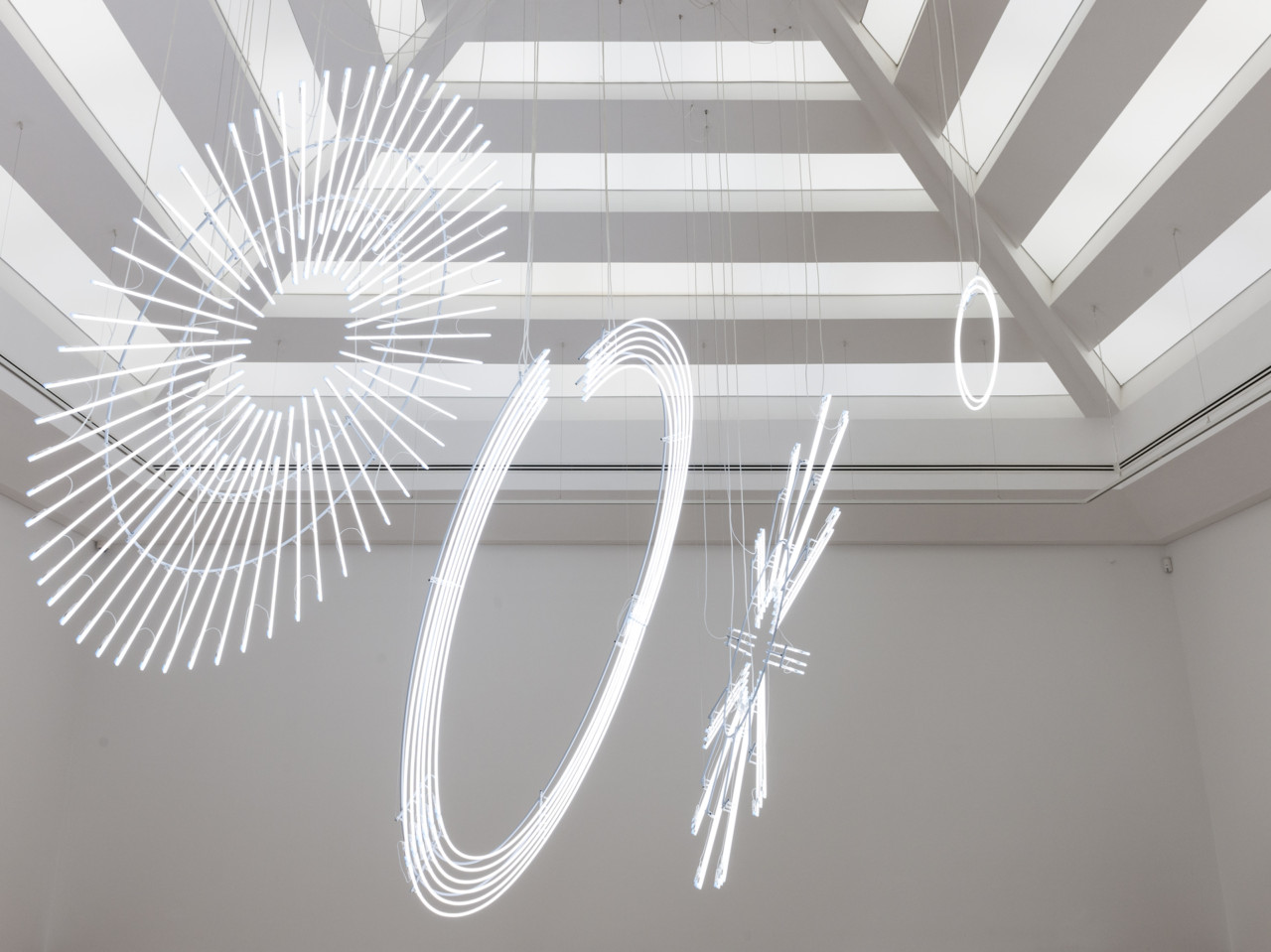


Cerith Wyn Evans, Radiant fold (…the Illuminating Gas), 2017/18. Presented to Amgueddfa Cymru – National Museum Wales by the Contemporary Art Society through Great Works, supported by the Sfumato Foundation, 2018. © Cerith Wyn Evans.
On Thursday this week we unveiled the second work to be acquired through the Great Works scheme, supported by the Sfumato Foundation. Following the donation of a painting by Glenn Brown to the Laing Art Gallery in Newcastle in 2017, this year we are proud to be able to give the first work by Cerith Wyn Evans to the National Museum of Wales.
Effortlessly occupying the whole of the new Colwinston Gallery, four elliptical forms drawn in fine white neon float underneath the ziggurat ceiling. Scaled most precisely to the proportions of this particular gallery, the work hovers in space, fed by looping skeins of electrical wiring. Neon is a naturally occurring element – it’s a gas, number 10 on the periodic table – and this work expresses that sense of something alive, contained inside the glass tubes. If you try to take a photo, your mobile phone will reveal to you the pulsing of the light that is not visible to the naked eye. As you walk around it the sculpture provokes a profound sense of calm, a yogic sensation of dynamic stillness.
Radiant fold (…the Illuminating Gas), 2017/18 references two of the most mysterious art works of the 20th century. Part of the title – “the Illuminating Gas” is the designation of one element of Marcel Duchamp’s Etant Donnés, his last major work, sprung upon an unsuspecting art world in 1969, a year after the artist’s death. He had given up art for over 25 years for a career in professional chess. The circular motifs of Wyn Evans’ sculpture are borrowed from a much earlier work of Duchamp’s, The Bride Stripped Bare by her Bachelors, Even (The Large Glass), a work begun in 1915 and completed in 1923.
Duchamp had borrowed these motifs from the standard opticians eye test. Instead of arranging the four circular forms on a flat surface, he stacked them and set them to float enigmatically within the symbolic schema of the lower panel of the work.
Cerith Wyn Evans has a long-held interest in language and in the process of translation. Raised bilingual, down the road in Llanelli, he has made work consisting of Latin palindromes, and transmitted text by John Cage as Morse code through a glass chandelier. Far from an academic or technical interest, this interest relates to the contemporary condition:
“I'm not a cynic or a pessimist in this respect, but I do think that forms of communication have changed irrevocably in the past 20 years. We are constantly mediated through information technologies that have changed the fundamental structure of what it is to communicate and to speak to another person.” [1]
In this work Wyn Evans takes the visual code appropriated by Duchamp as the First World War raged across Europe and isolates it, thereby giving it new agency as a fulcrum for enquiry into the act of looking for our 21st century context. As you walk around the sculpture, the individual elements perform constantly changing relationships with each other, emphasising the sensation of motion stilled. With physical proximity, you become aware that the lowest element hovers only a couple of feet above the ground, a fall arrested just short of disaster.
The artist has spoken before about his interest in the writings of film maker and writer Hito Steyerl, and has referenced in particular her 2011 essay Freefall: A thought experiment on Vertical Perspective that dealt with the question of the aerial viewpoint that increasingly characterises our era. Google Maps, for example, 3D cinema and drone technology as used in recent conflicts have accustomed us to this view from above – a view that also removes the horizon.
“And with the loss of horizon also comes the departure of a stable paradigm of orientation, which has situated concepts of subject and object, of time and space, throughout modernity. In falling, the lines of the horizon shatter, twirl around, and superimpose.” [2]
Radiant fold (…the Illuminating Gas), 2017/18 is a work that allows itself to be understood in a multitude of ways: as drawing in space, as sculpture, as immersive installation. The artist is meticulously careful not to prescribe readings, nor shut down approaches that may be more subjective. This floating, falling, suspended, glowing work also carries within it the possibility of engaging with a philosophical discussion that anchors it wholly within this specific moment of technological development.
Caroline Douglas
Director
National Museum Cardiff, Cathays Park, Cardiff CF10 3NP. Tuesday – Sunday 10.00-17.00. Exhibition continues until 2 September 2018. www.museum.wales